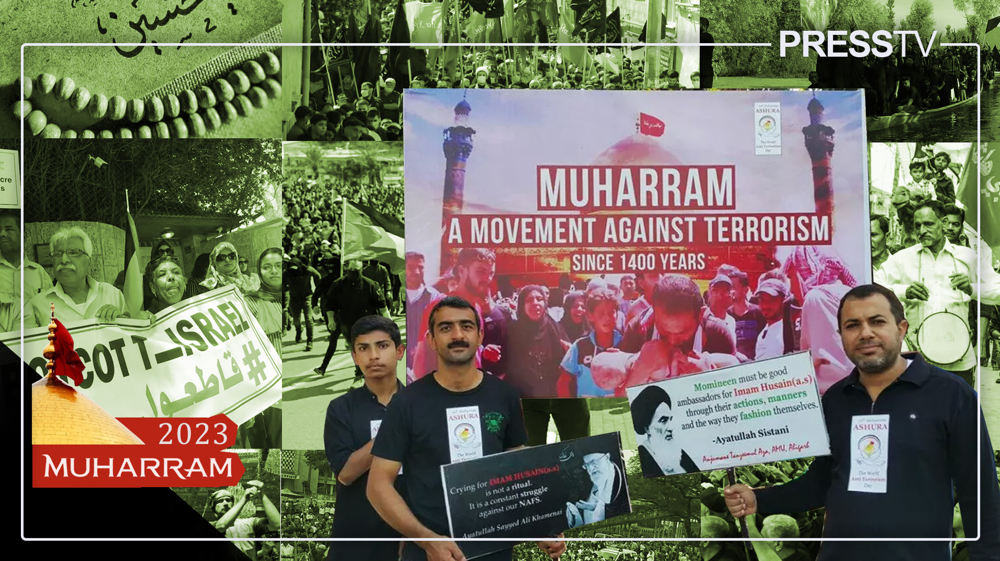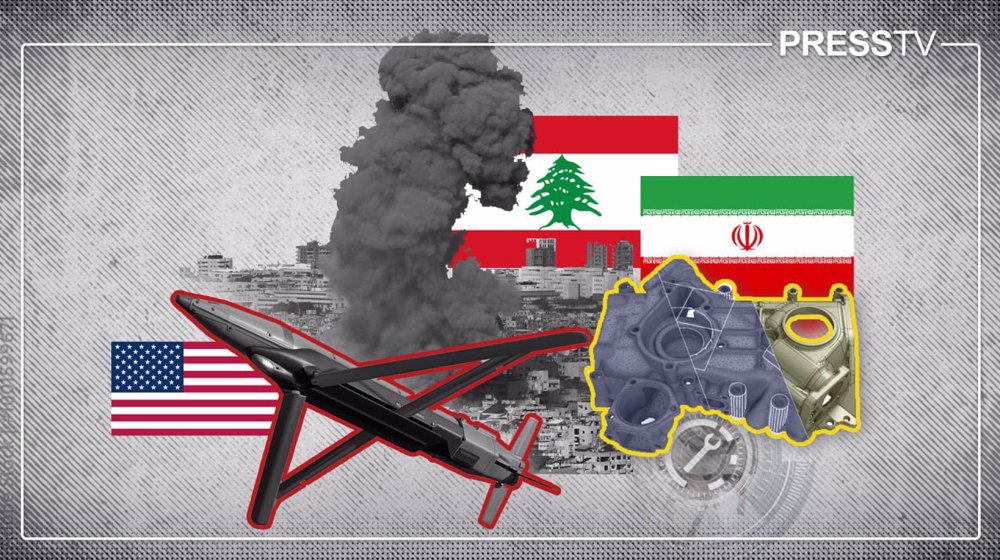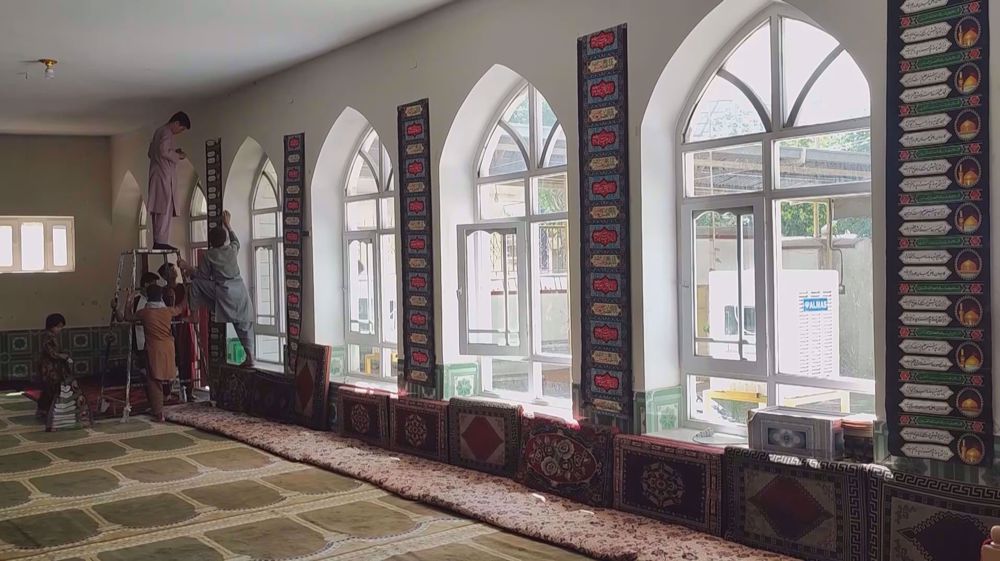Karbala paradigm and unceasing struggle against oppression, injustice
By Xavier Villar
For Muslims worldwide, particularly Shia Muslims, the month of Muharram is one of the most intense periods in the Islamic calendar because of its huge historical significance.
During this month, Muslims from all backgrounds commemorate the martyrdom of Hussain ibn Ali (AS), the grandson of Prophet Muhammad (PBUH), and his companions in Karbala in the year 680 AD.
The main ceremonies on Ashura, the tenth of Muharram, consist of public expressions of mourning and reaffirmation of a pledge to the principles exemplified by Imam Hussain (AS) and his companions against the corrupt Umayyad ruler of the time, Yazid.
One of the most common manifestations of this mourning is the ta'ziyeh. This term denotes expressions of "sympathy," "mourning," and "consolation," and can be understood as an Islamic drama that, through performances, poetic recitations, and songs, recounts the greatest tragedy of all times.
While the spiritual aspect of Muharram is significant, the political aspect should not be overlooked. Despite being a historical event, it can be said that the martyrdom of Imam Hussain (AS) functions as an ontological paradigm of the struggle between oppression and the suffering caused by it.
The division between oppressors and oppressed, known as mostakberin and mostazafin in Quranic language, is the Islamic ontological division of the world.
Simultaneously, it serves as a political division that publicly distinguishes between friends and foes.
The enemies are characterized by a complete absence of justice, making them antithetical to any form of political articulation based on Islam.
In this context, it is important to recall that in the Quranic chapter al-Qasas, there is an unequivocal preferential option for the oppressed. This preferential option for the oppressed is reflected in the identification of God Himself with the mostazafin.
In onto-political terms, it can be said that the events of Karbala represent an important episode in the perennial struggle against the category of taghut. Taghut, derived from the Arabic verb tagha, means to dominate or transgress the limits.
The Quran repeatedly warns against those who "transgress the bounds of justice by dominating and oppressing others."
It is also in the Quran where the story of Moses and Pharaoh is found, in which the latter's name ceases to be the name of an individual and becomes a symbolic reference to any domination that violates the principles of equity.
The paradigm of Karbala, therefore, represents an ongoing political struggle against oppression, injustice, and domination. Moreover, a connection can be established between Imam Hussain (AS), the mostazafin, and the need to articulate a response that allows for a different way of being in the world, distinct from the hegemonic one.
On the other hand, this hegemonic way of being in the world is related, in turn, to Yazid, the tyrant who ordered the martyrdom of Imam Hussain (AS), to the mostakberin, to the archetypal figure of Pharaoh, to the category of taghut, and finally to the epistemological domination characteristic of the West.
During the events of 15 Khordad of 1963 - which corresponds to June 5, 1963 in the Gregorian calendar – founder of the Islamic Revolution Imam Khomeini employed the same political-ontological paradigm by comparing the Shah with Yazid.
The 15 Khordad movement was the necessary and crucial precursor to the Islamic Revolution of 1979. In political terms, it can be seen as the initial moment when Imam Khomeini's anti-Western critique managed to open up political space in Iran.
The uprising triggered by this movement became the greatest threat that the Pahlavi dynasty had faced since former PM Mohammad Mossadegh, and it was the first time that Kemalism, the name given to Western discourse in Muslim countries, was challenged by a political response articulated in the language of Islam. This contrasted with Mossadegh's approach, which remained within Western ideological parameters.
The political use of the Karbala paradigm reemerges in a speech given by Imam Khomeini in 1979, months before his triumphant return to Iran after years in exile.
In a speech titled "The Fortieth Day After Ashura," Imam Khomeini established a connection between the martyrs of the Islamic Revolution and the martyrs of Karbala.
"It is as if the blood of our martyrs continues the bloodshed of the martyrs of Karbala, and as if the commemoration of our brothers echoes the commemoration of those brave souls who fell in Karbala. Just as their pure blood put an end to the tyrannical rule of Yazid, the blood of our martyrs has shattered the tyrannical monarchy of the Pahlavi dynasty,” he said.
This speech exemplified, on one hand, the importance of Karbala, the martyrdom of Imam Hussain (AS), and the observance of Muharram as political archetypes in the struggle against oppression.
On the other hand, it underscored the Islamic genealogy of this very struggle. As previously noted, this struggle is intricately linked to the resistance against oppression and, more broadly, is centered around the constant pursuit of justice.
The use of the Karbala paradigm by Imam Khomeini and his followers also highlights the relevance and continuity of the ontological division between the oppressed and oppressors, as previously mentioned.
This political articulation centered around the Karbala paradigm is explained by Imam Khomeini's explicit rejection of the concept of intizar, which can be translated as quietism.
This concept posits that every government is illegitimate in the absence of the twelfth Imam, but in any case, any government is better than its absence.
Imam Khomeini made it clear that in the absence of Imam Mahdi (AS), the savior of humanity, Muslims should strive to live under an Islamic government. His political practice modified the idea of intizar, transforming it from a passive wait for the Imam's return into an active, political, effort to pave the way for his return.
In this regard, it is important to remember that Imam Khomeini successfully re-conveyed the message of the Karbala paradigm to center the struggle against the injustice of the mostakberin in this world. This necessitates analyzing his thoughts from a political perspective, and not exclusively from a theological standpoint.
The phrase used by revolutionary activists during the 1979 Islamic Revolution - "Every place is Karbala and every day is Ashura – stands today as a powerful reminder of the prevailing political relevance of the Karbala paradigm and emphasizes the unceasing pursuit of justice that it symbolizes.
It is also important to note the significance of the mostazafin as political actors, both in the 15th of Khordad and the Islamic Revolution, and their connection to the struggle for justice represented by Imam Hussain (AS).
Xavier Villar is a Ph.D. in Islamic Studies and researcher who divides his time between Spain and Iran.
(The views expressed in this article do not necessarily reflect those of Press TV)
Iran’s soft power to quench regional thirst for healthy beverages
Ansarullah: South Yemen proxy war meant to help Israeli dominance
Explainer: How America’s foster care system harms children instead of protecting them
‘A full year of injustice’: Son of Gaza doctor Abu Safiya demands his immediate release
Trump: Zelensky doesn’t have anything ‘until I approve it’
VIDEO | Press TV's news headlines
Hezbollah rejects internal discord, will not fight Lebanese army: Senior official
VIDEO | Severe weather floods coastal roads in southern France















 This makes it easy to access the Press TV website
This makes it easy to access the Press TV website